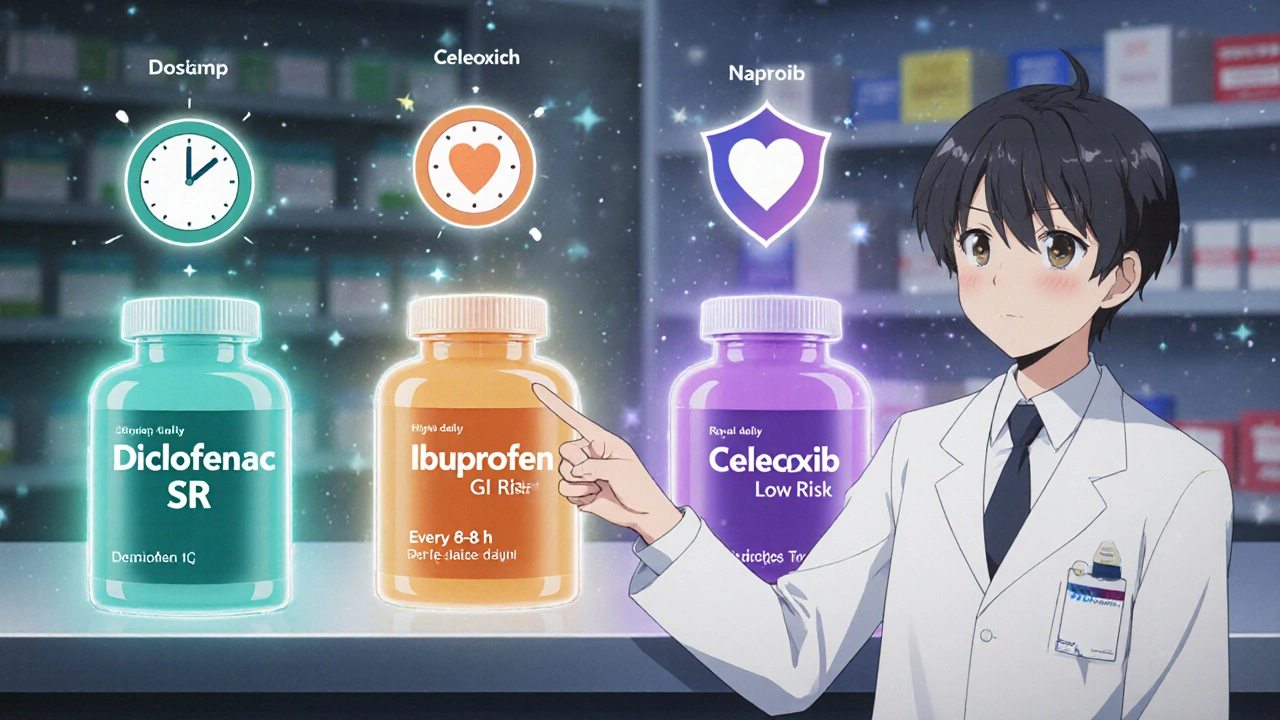NSAID Selector Tool
Personalized NSAID Recommendation
Select your pain type and health conditions to get a tailored recommendation based on medical guidelines.
Recommendation
Select your pain type and health conditions to see a personalized recommendation.
Key Takeaways
- Diclofenac SR offers a twice‑daily dosing schedule, useful for chronic pain but carries GI and cardiovascular risks.
- Ibuprofen is cheap and widely available, best for short‑term mild‑to‑moderate pain.
- Naproxen provides the longest half‑life among over‑the‑counter NSAIDs, making it a solid option for sustained inflammation.
- Celecoxib, a selective COX‑2 inhibitor, lowers GI side‑effects but may increase cardiovascular risk for certain patients.
- Choosing the right NSAID depends on the condition treated, comorbidities, and personal tolerance.
What Is Diclofenac SR?
Diclofenac SR (sustained‑release) is a non‑steroidal anti‑inflammatory drug (NSAID) formulated to release the active ingredient slowly over 12 hours, allowing twice‑daily dosing. It works by inhibiting cyclooxygenase (COX) enzymes, which reduces prostaglandin production and therefore pain, swelling, and fever. The SR version is often prescribed for osteoarthritis, rheumatoid arthritis, and chronic musculoskeletal pain.
How Does Diclofenac SR Compare to Common NSAID Alternatives?
When doctors talk about “NSAID alternatives,” they usually mean other drugs that hit the same COX pathway but differ in potency, dosing schedule, and safety profile. Below is a quick look at the most frequently used alternatives.
Comparison Table
| Attribute | Diclofenac SR | Ibuprofen | Naproxen | Celecoxib |
|---|---|---|---|---|
| Drug class | Non‑selective NSAID | Non‑selective NSAID | Non‑selective NSAID | Selective COX‑2 inhibitor |
| Typical dose (adult) | 50‑150 mg BID | 200‑400 mg Q6‑8h | 250‑500 mg BID | 100‑200 mg Q12h |
| Half‑life | ≈ 8 h (sustained release) | ≈ 2 h | ≈ 12-17 h | ≈ 11 h |
| GI risk (ulcers/bleeding) | High | Moderate | Moderate‑high | Low |
| Cardiovascular risk | Elevated | Low‑moderate | Low | Elevated (COX‑2) |
| OTC availability | Prescription only (US) | OTC | OTC (lower strength) | Prescription |
| Typical use cases | Chronic arthritis, post‑operative pain | Headache, mild‑to‑moderate pain, fever | Back pain, menstrual cramps, arthritis | Arthritis in patients at GI risk |

When to Choose Diclofenac SR
If you need steady pain control for an entire day without remembering to pop a pill every few hours, Diclofenac SR’s twice‑daily schedule shines. It’s especially helpful for patients with chronic osteoarthritis who experience morning stiffness that lasts throughout the day.
However, the drug’s non‑selective COX inhibition means it’s tougher on the stomach. Anyone with a history of ulcers, gastrointestinal (GI) bleeding, or who takes anticoagulants should think twice before starting Diclofenac SR.
When Alternatives Might Be Better
Ibuprofen shines for short‑term aches-think a migraine or a sprained ankle. Because it’s OTC and inexpensive, it’s the go‑to for most households. If you need something stronger for a few days, a higher dosage (400 mg every 6‑8 hours) can be used, but you still need to watch for stomach upset.
Naproxen boasts the longest half‑life among common NSAIDs, allowing once‑ or twice‑daily dosing that rivals Diclofenac SR’s convenience. Its GI risk is similar to ibuprofen, but it may be gentler on the kidneys for some patients.
Celecoxib is a selective COX‑2 inhibitor, designed to spare the stomach lining. For people with a prior ulcer history, celecoxib can be a lifesaver-provided they don’t have uncontrolled hypertension or high cardiovascular risk, because COX‑2 selectivity can raise heart‑attack risk.
Safety Tips Across All NSAIDs
- Take the lowest effective dose for the shortest time needed.
- Always take with food or milk to blunt stomach irritation.
- Avoid combining two NSAIDs; the risk of bleeding rises sharply.
- Check with a doctor if you have kidney disease, heart failure, or are on blood thinners.
- Pregnant women should generally avoid NSAIDs after the third trimester.

Case Scenarios: Picking the Right Option
Scenario 1 - Chronic Knee Osteoarthritis
Patient profile: 68‑year‑old with a history of mild gastritis, on low‑dose aspirin for heart health.
Best choice: Diclofenac SR may be too harsh on the stomach, even with a proton‑pump inhibitor. A better fit could be celecoxib, given the GI safety, but the patient’s cardiovascular profile warrants close monitoring. If cardiovascular risk is high, low‑dose naproxen (under doctor supervision) might strike a balance.
Scenario 2 - Acute Migraine
Patient profile: 35‑year‑old, no chronic conditions, needs fast relief.
Best choice: Ibuprofen 400 mg with a triptan works quickly and is easy to access. No need for a sustained‑release formula.
Scenario 3 - Post‑Surgical Pain
Patient profile: 50‑year‑old, recovering from knee arthroscopy, no GI history.
Best choice: Diclofenac SR can provide steady analgesia without the frequent dosing that might disrupt sleep. Monitoring renal function is still needed.
Bottom Line: Weighing Benefits vs. Risks
There’s no one‑size‑fits‑all answer. Diclofenac SR gives you convenience and strong anti‑inflammatory power, but you pay with higher GI and cardiovascular risk. Ibuprofen and naproxen are cheaper, more familiar, and work well for short‑term pain. Celecoxib shines when stomach protection is a priority, yet you must keep an eye on heart health.
The smartest move is to match the drug to the patient’s overall health picture, not just the pain level. Talk to your healthcare provider about your medical history, other meds, and lifestyle before locking in a choice.
Frequently Asked Questions
Can I take Diclofenac SR with ibuprofen?
No. Combining two non‑selective NSAIDs increases the chance of stomach bleeding and kidney damage. Use one or the other, and only under doctor guidance.
Is Diclofenac SR safe for seniors?
Seniors are more prone to GI ulcers and kidney issues. If a doctor prescribes Diclofenac SR, it’s usually paired with a proton‑pump inhibitor and close monitoring of kidney function.
How quickly does Diclofenac SR start working?
Because it’s a sustained‑release formulation, peak plasma levels appear 4‑6 hours after dosing, but many patients notice pain relief within the first 2 hours.
Can I use Diclofenac SR if I have heart disease?
Patients with established cardiovascular disease should avoid diclofenac unless no alternatives exist, because it can raise the risk of heart attack or stroke.
What’s the difference between a regular and sustained‑release diclofenac pill?
Regular diclofenac releases the drug immediately, requiring multiple doses per day. The SR (sustained‑release) matrix releases the drug slowly, allowing twice‑daily dosing and more stable blood levels.
Are there natural alternatives to diclofenac for inflammation?
Yes-turmeric (curcumin), omega‑3 fatty acids, and ginger have modest anti‑inflammatory effects, but they’re generally less potent than prescription NSAIDs and should be used as adjuncts, not replacements, for severe conditions.



6 Comments
Clinton Papenfus October 25, 2025 AT 14:09
Diclofenac SR provides sustained analgesia for patients requiring consistent pain control. Its twice daily dosing improves adherence compared to more frequent regimens. However the non selective COX inhibition raises gastrointestinal risk. Clinicians must balance efficacy with safety.
Zaria Williams November 3, 2025 AT 01:04
i think u should look at the GI profile first, cuz it’s definitely a deal breaker for many. ibuprofen might be a cheaper option but it can still mess up your stomach if you overdo it.
Tamara Tioran-Harrison November 11, 2025 AT 11:58
While the brochure extols the virtues of diclofenac, one must recall that any drug bearing a COX‑inhibitor label carries inherent peril. The notion that a sustained‑release tablet magically eliminates risk is, frankly, laughable. Patients with cardiovascular concerns should be steered away, unless they enjoy courting danger. :)
kevin burton November 19, 2025 AT 22:53
Diclofenac SR works by slowly releasing the active ingredient over twelve hours.
This pharmacokinetic profile allows patients to take the medication twice a day.
For chronic conditions such as osteoarthritis the steady plasma level can reduce morning stiffness.
The drug inhibits both COX‑1 and COX‑2 enzymes, which lowers inflammation and pain.
Because COX‑1 inhibition also protects the stomach lining, the gastrointestinal side effects are higher than with selective agents.
Studies have shown an increased incidence of gastric ulcers in patients using diclofenac without a protective proton pump inhibitor.
The cardiovascular risk is another important consideration, especially in older adults with a history of heart disease.
Compared with ibuprofen the relative risk of heart attack appears modestly higher, though the data are not unanimous.
Naproxen, on the other hand, has been associated with a lower cardiovascular profile in several meta‑analyses.
Celecoxib, being COX‑2 selective, reduces stomach irritation but carries its own heart safety warnings.
When deciding on an NSAID the clinician should first assess the patient’s GI and cardiac risk factors.
If the patient has a history of ulcers, adding a proton pump inhibitor or choosing celecoxib may be prudent.
If the patient has uncontrolled hypertension, avoiding diclofenac and celecoxib is advisable.
For short‑term pain such as a migraine, ibuprofen remains an inexpensive and effective first line option.
For long‑lasting inflammation, naproxen or diclofenac SR can provide more convenient dosing schedules.
Ultimately the choice should be individualized, balancing efficacy, dosing convenience, and the patient’s overall health picture.
Max Lilleyman November 28, 2025 AT 09:47
Nice breakdown, but remember most patients just grab the cheapest pill from the pharmacy 😊. Cost and access often trump pharmacology in real life.
Brett Witcher December 6, 2025 AT 20:42
The comparative half‑life data suggest that diclofenac SR approximates naproxen’s dosing convenience while retaining a higher COX‑1 mediated risk profile.